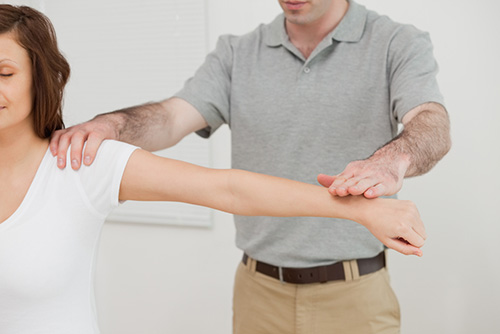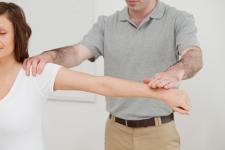What is a Rotator Cuff?
Your rotator cuff located in your shoulder and is a network of muscles – four, to be exact – that come together as tendons to form a covering around the head of the humerus and work to keep your arm in the shoulder socket. The rotator cuff also attaches the humerus to the shoulder blade and helps to lift and rotate your arm. Between the bone and rotator cuff is a lubricating sac – called a bursa – which lets the tendons within the rotator cuff glide smoothly and freely when your arm is moved. When one or more of the tendons in the rotator cuff are torn, it’s no longer fully attached to the head of the humerus – in many cases, torn tendons begin by fraying and, as the damage progresses, the tendon can tear completely. It’s also important to note that when the tendons of the rotator cuff are injured, the bursa can become inflamed and painful.

Types of Rotator Cuff Injuries
There are two main causes of rotator cuff injuries, which are degeneration and injury.
With a degenerative (chronic) rotator cuff tear, the tendon is worn down slowly over time as we age and are more common in your dominate arm. Repetitive stress caused by performing the same shoulder motion for long periods of time – like throwing a baseball, swinging a tennis racquet, rowing, or lifting above your head – can cause stress on your rotator cuff. As we get older the blood supply to the tendons that make up the rotator cuff lessens, which inhibits the body to efficiently repair any damage that is sustained.
Injuries – such as falling on an outstretched arm or lifting something that’s too heavy – can result in a tear in the rotator cuff as well. This type of tear can occur with other shoulder injuries, too, such as a dislocated shoulder or a broken collarbone. When it comes to younger adults and rotator cuff injuries, most tears are caused by traumatic events, such as a fall.
Symptoms of a Rotator Cuff Injury or Tear
The most common symptoms of a rotator cuff tear are:
- Pain at rest and at night, particularly if lying on the affected shoulder
- Pain when lifting and lowering your arm or with specific movements
- Weakness when lifting or rotating your arm
- A crackling sensation when moving your shoulder in certain positions
Tears that happen suddenly, such as from a fall, usually cause intense pain. There may be a snapping sensation and immediate weakness in your upper arm.
What Can Be Done for a Rotator Cuff Tear?
Just like acute pain, chronic shoulder and arm pain are good reasons to see your doctor. Early treatment can prevent your symptoms from getting worse. It will also get you back to your normal routine that much quicker. The goal of any treatment – be it for a chronic or acute injury – is to reduce pain and restore function. There are several treatment options for a rotator cuff tear, and the best option is different for every person. If you have a rotator cuff tear and you keep using it despite increasing pain, you may cause further damage. A rotator cuff tear can get larger over time.
Nonsurgical treatment of a rotator cuff injury includes rest, activity modification, anti-inflammatories (such as ibuprofen), physical therapy, and steroid injections. If nonsurgical treatment isn’t successful, your orthopaedic surgeon may recommend surgery to correct the tear. There are a few different options for repairing rotator cuff tears, and your orthopaedic surgeon will discuss with you which one is best for your particular situation.
Dr. Hurlbut and his incredible team of nurses and physical therapists here at Prairie Orthopaedic and Plastic Surgery specialize in diagnosing, treating, and rehabilitating shoulder disorders and injuries. So, if you’re dealing with shoulder pain, please don’t hesitate to give us a call!

